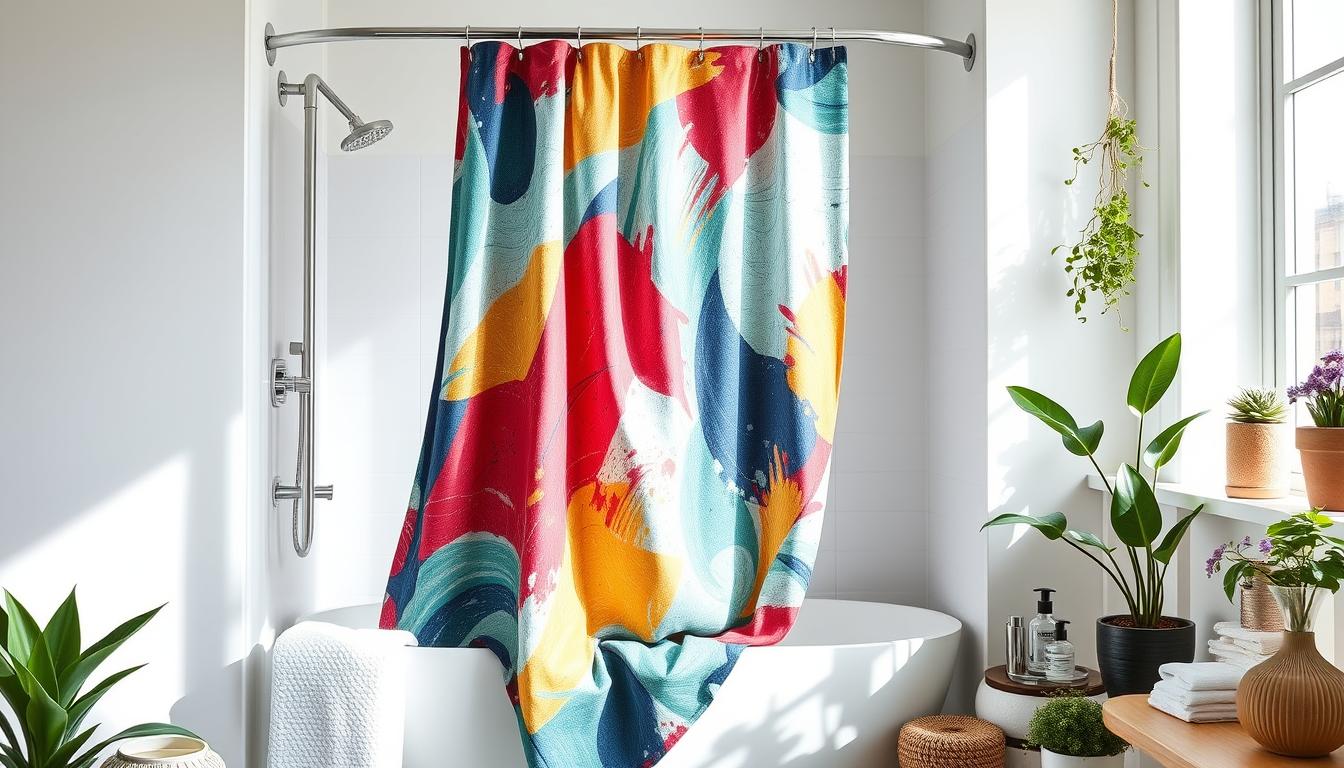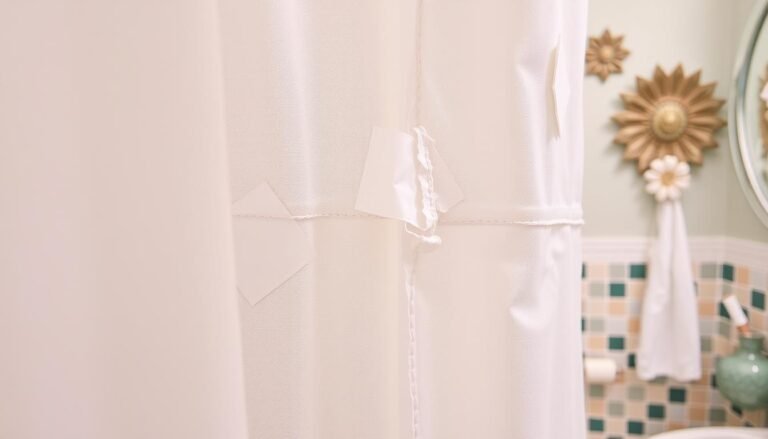Using Fabric Shower Curtains Without Liners: Tips & Advice
Changing your bathroom decor to a fabric shower curtain might seem hard at first. But, a lot of people love this switch. Fabric shower curtains made from materials like woven polyester/nylon are easy to clean in the washer.
When we switched to a linen shower curtain, our vintage bathroom looked better. This curtain soaked up water well, easing our worry about spills. With different materials like linen and hemp, we found the perfect size for our space.
To keep the curtain mold-free, we didn’t let it touch the tub while showering. We also hung it in a breezy room to dry. By following these shower curtain tips, our bathroom stayed clean and looked great.
If you want something easy, think about a quick-drying waterproof nylon curtain. This choice doesn’t need a liner. Many hotels use washable curtains from sturdy cotton canvas or polyester/nylon. These materials last long and are simple to care for.
Can a Fabric Shower Curtain Be Used Without a Liner?
Many homeowners ask if they can hang a fabric shower curtain without a liner. The answer isn’t simple. It depends on the type of fabric, how well-ventilated your bathroom is, and what you prefer. There are both good and bad points to think about before you decide.
Pros of Using Fabric Shower Curtains Without Liners
- Environmental Impact: Skipping the plastic liner is better for our planet. You reduce your environmental footprint this way.
- Aesthetic Appeal: Fabric curtains offer more styles and can look nicer than plastic ones.
- Ease of Maintenance: Fabric curtains are often easy to clean in the washing machine. This is simpler than dealing with plastic liners that can get moldy or stained.
- Quick Drying Materials: Certain fabrics, like linen and hemp, dry fast. This helps prevent mold and mildew.
Cons to Consider Before Ditching the Liner
But, there are some downsides to using a fabric shower curtain alone. These factors might affect your choice:
- Shrinkage Issues: Washing fabrics can cause them to shrink. You can avoid this by buying a slightly bigger curtain.
- Position of Showerhead: If your showerhead is not placed correctly, water might splash out. In this case, you might still need a liner.
- Cost Considerations: Fabric curtains can cost more than plastic ones. If you’re on a tight budget, you may need to think twice.
- Routine Care Required: Keeping your curtain clean with regular washing and good ventilation is key. This takes some effort.
In the end, whether to use a fabric shower curtain without a liner depends on your own situation. Weighing the advantages and disadvantages helps you make a choice that fits your home and lifestyle.
Advantages of Fabric Shower Curtains Over Plastic
In the debate of fabric vs plastic shower curtain, fabric choices shine through. They bring several key benefits. These include better looks and being easier on the planet and our health.
Aesthetic Appeal and Customization Options
Fabric shower curtains are truly elegant and highly customizable. They come in many colors, textures, and patterns. This variety lets you make your bathroom uniquely yours in a way plastic can’t match. The way fabric falls naturally adds grace, making your bathroom feel welcoming.
Environmental Benefits
Choosing fabric curtains is good for the earth. They can be made from natural materials like organic cotton or hemp. Even OEKO-TEX certified linen is an option. These options are not just earth-friendly but also break down over time, lessening your environmental impact. Plastic curtains, on the other hand, can give off nasty chemicals like VOCs. Fabric choices are cleaner for the planet, avoiding the harms of single-use plastics.
Health Considerations
When it comes to health, fabric outperforms plastic. PVC plastic curtains may let off dangerous VOCs and phthalates. These chemicals can mess with your hormones and breathe, causing long-term health problems. Fabric curtains, especially those without toxic chemicals, are much safer. They can also stop mold and are easy to clean, making your bathroom a healthier space.
Looking for more health tips? Check out shower curtains at this link.
Best Materials for Fabric Shower Curtains
Choosing the right materials for your shower curtain is important. It affects your bathroom’s look and functionality. Organic fabrics offer sustainability, durability, and beauty.
Linen Shower Curtains
Linen is great for bathrooms because it dries quickly. It looks luxurious and can fit any bathroom size. But it might shrink after washing.
Pre-washing linen reduces shrinkage. Otter Wax can make linen curtains waterproof, improving their use.
Cotton Canvas Shower Curtains
Cotton canvas is durable with a timeless look. Brands like Utility Canvas and Vermont Country Store offer high-quality options. These curtains work well in any bathroom and minimize water spillage.
However, think about your shower layout and tub size. Organic options are available for eco-conscious shoppers.
Hemp Shower Curtains
Hemp is environmentally friendly, not needing pesticides or fertilizers. It resists mildew, perfect for moisture-prone bathrooms. Hemp curtains are both green and durable.
They suit those who prefer eco-friendly options. With regular care, they remain mold-free and last longer.
Maintenance Tips for Fabric Shower Curtains
Keeping your bathroom fresh and clean is important. One tip is to keep the shower curtain outside the tub while showering. Then, put it back once dry. This helps it dry without moisture being trapped. Also, using bathroom fans or leaving the door open aids in preventing mold.
It’s vital to wash your curtain regularly. Fabric, plastic, and vinyl curtains can go in the washing machine. Use gentle cycles with warm water and the highest water level for fabric ones. This avoids damage. Curtains should be washed at least once a month due to daily use.
Another cleaning method is to soak the curtain in oxy powder and borax overnight. After soaking, wash and iron it on one side. This approach is good for polyester liners that dry quickly and prevent water from passing through. Polyester fabric shower liners are great for low maintenance.
Handwashing is an option for those who like a hands-on approach or need to scrub more. Regardless of the method, making sure the curtain dries completely is crucial.
Check out this discussion on fabric shower curtains for tailored advice. Also, this guide on using duvet covers may offer additional insights for home improvements.
Some choose to pair decorative cotton shower curtains with machine washable liners for style and function. Wide fabric curtains are preferred to avoid flapping and sticking, enhancing convenience.
To sum up the main tips:
| Tip | Description |
|---|---|
| Drying | Keep the curtain outside the tub; use bathroom fans. |
| Machine Washing | Gentle cycle, warm water, high water level, once a month. |
| Alternative Cleaning | Soak in oxy powder and borax, then wash and iron one side. |
| Handwashing | For additional scrubbing and hands-on cleaning. |
| Material | Polyester liners for quick drying and water resistance. |
| Combination | Cotton outer curtain with machine washable liners. |
How to Install a Fabric Shower Curtain Without a Liner
Learn to set up a fabric shower curtain without a liner and boost your bathroom’s look. These tips will help you switch from traditional curtains to a stylish fabric choice with ease.
Step-by-Step Guide
Start by picking the right fabric for your shower curtain. Choose light-filtering materials like polyester, linen, or cotton. Stay away from blackout curtains as they don’t handle water well. Then, cut your fabric to fit just like a waterproof liner does.
Using two curtain panels usually looks best, giving a fuller, flowy style. Measure your shower’s width and height, then cut slits for the hooks. Hang the curtain with either ball-style hooks or clips on rings. A versatile tension rod will work great for this.
Make buttonholes at the slits with a sewing machine, or use grommets for an easier option. This makes your curtain strong and easy to use.
Tools and Materials Needed
Here’s what you’ll need to put up your shower curtain:
- Measuring tape
- Scissors
- Sewing machine or grommets
- Shower hooks (12 hooks are recommended)
- Tension rod (for flexibility)
- 2 window curtain panels (54 inches wide each)
- Ball-style curtain hooks or rings with clips
For creative designs, see this guide on using window curtains for showers. It offers great customization ideas to beautify your bathroom.
Once the fabric shower curtain is up, keep it water-resistant by washing as the material requires. Ironing after washing will keep it looking good and functioning well.
Handling Mold and Mildew in Fabric Shower Curtains
Mold and mildew on fabric shower curtains is a common issue, especially in moist, warm places like bathrooms. To keep your shower curtain looking new and mold-free, it’s important to use good cleaning and prevention methods. These steps keep your bathroom healthy and extend your shower curtain’s life.
Preventative Measures
To stop mold, you need to reduce moisture in your bathroom. Make sure your bathroom is well-ventilated by using the fan for about 30 minutes after you’ve showered. Also, keep your curtain fully spread out to let air flow around it. Hooks that dry quickly, such as S-shaped or Omega-shaped, can help too.
Prevent your curtain from sticking to wet surfaces by using ones with heavy hems or a curved rod. Protect your curtain further by applying a natural wax that makes it waterproof. Or, use a washable fabric liner, like the Fabric Shower Liner from Made By Design, which fights against mold.
Cleaning Techniques
Keeping your shower curtain clean is key to fighting mold and mildew. Wash your curtain, liner, rings, and rod every month. Each week, spray the liner with a bathroom cleaner. Keep humidity in the bathroom between 35% and 50% to keep mold at bay.
Vinegar kills about 82% of mold types found on shower curtains. Hydrogen peroxide is a gentle bleach that gets rid of mold spores and stains. Baking soda cleans stains but doesn’t stop mold growth. Use diluted chlorine bleach for tough mold, but watch out for color fading. Deep clean your bathroom every week and leave the shower curtain slightly open to dry out moisture.
Using these cleaning methods for fabric shower curtains lowers mold risk. Your bathroom stays safe and inviting.

Hey there, I’m Alex Hanson and I’m passionate about all things covers! Whether you’re looking for a car seat cover to protect your vehicle or an oven cover to keep your kitchen clean, I’m here to help. With years of experience in the industry, I have plenty of knowledge and insights to share with my readers. So, if you care about protecting your belongings and making them look their best, you’re encouraged to read my blog as I explore the perfect cover for every need.







